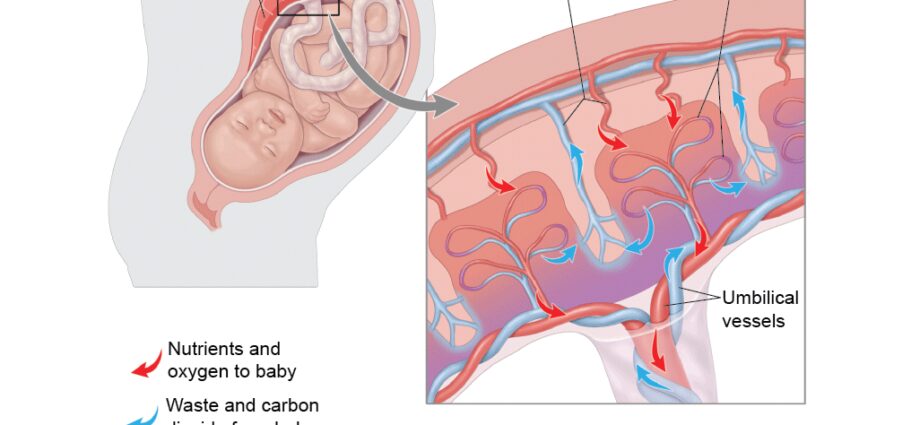Contents
Throughout pregnancy, the placenta acts as an airlock. It is a kind of platform for exchange between mother and baby. This is where, thanks to its cord, the fetus draws the nutrients and oxygen carried by the maternal blood.
The placenta nourishes the fetus
The primary role of the placenta, an ephemeral organ with extraordinary powers, is nourishment. Hooked to the uterus and connected to the baby by the cord via a vein and two arteries, this kind of large sponge saturated with blood and villi (networks of arteries and veins) is the place of all exchanges. From the 8th week, it provides water, sugars, amino acids, peptides, minerals, vitamins, triglycerides, cholesterol. Perfectionist, it collects waste from the fetus (urea, uric acid, creatinine) and releases them into the maternal blood. He is the baby’s kidney and his lung, supplying oxygen and evacuating carbon dioxide.
What does the placenta look like?
Completely formed in the 5th month of pregnancy, the placenta is a thick disc 15-20 cm in diameter that will grow over the months to reach term at a weight of 500-600 g.
The placenta: a hybrid organ adopted by the mother
The placenta carries two DNAs, maternal and paternal. The mother’s immune system, which normally rejects what is foreign to her, tolerates this hybrid organ … which wants her well. Because the placenta participates in the tolerance of this transplant which is actually pregnancy, since half of the antigens in the fetus are paternal. This tolerance is explained by the action of the mother’s hormones, which hunt certain white blood cells that can activate the immune system. An excellent diplomat, the placenta acts as a buffer between the mother’s immune system and that of the child. And achieves a feat: make their two bloods never mix. The exchanges take place through the walls of the vessels and villi.
The placenta secretes hormones
The placenta produces hormones. From the very beginning, via the trophoblast, an outline of the placenta, it produces the famous beta-hCG : this one is used to modify the maternal body and supports a good evolution of the pregnancy. Also progesterone which maintains the pregnancy and relaxes the uterine muscle, estrogens which participate in the proper fetal-placental development, placental GH (growth hormone), placental lactogenic hormone (HPL) …
Medicines that pass or do not pass the placental barrier …
Large molecules like heparin do not pass the placenta. Thus a pregnant woman can be put on heparin for a phlebitis. Ibuprofen crosses and is to be avoided: taken during the 1st trimester, it would be harmful for the future formation of the reproductive system of the fetus boy, and taken after the 6th month, it can involve a risk of cardiac or renal failure. Paracetamol is tolerated, but it is better to limit its intake to short periods.
The placenta protects against certain diseases
The placenta plays a barrier role preventing the passage of viruses and infectious agents from the mother to her fetus, but it is not impassable. Rubella, chickenpox, cytomegalovirus, herpes manage to sneak in. The flu too, but without too many consequences. While other diseases like tuberculosis hardly ever pass. And some cross more easily at the end of pregnancy than at the beginning. Please note that the placenta allows alcohol and the components of the cigarette to pass through !
On D-Day, the placenta sounds the alert to trigger childbirth
After 9 months, it has had its day, and is no longer able to provide the enormous energy supply needed. It’s time for the baby to breathe and feed out of his mother’s womb, and without the help of his inseparable placenta. This then plays its ultimate role, sending alert messages which participate in the initiation of birth. Faithful to the post, until the end.
The placenta at the heart of many rituals
About 30 minutes after birth, the placenta is expelled. In France, it is incinerated as “operational waste”. Elsewhere, it fascinates. Because he is considered a twin of the fetus. That he has the power to give life (by feeding) or death (by causing bleeding).
In southern Italy, it is considered to be the seat of the soul. In Mali, Nigeria, Ghana, double the child. The Maori of New Zealand buried him in a pottery to tie the baby’s soul to the ancestors. The Obandos of the Philippines bury him with miniature tools so that the child becomes a good worker. In the United States, some women go so far as to demand that their placenta be dehydrated to swallow it in capsules, supposed to improve lactation, strengthen the uterus or limit postnatal depression (this practice has no scientific basis).










